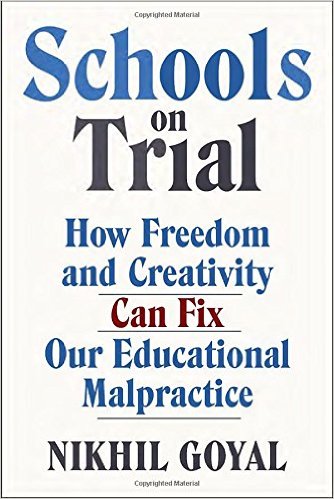In Schools on Trial: How Freedom and Creativity Can Fix Our Educational Malpractice by Nikhil Goyal asks:
Are America’s schools little more than cinderblock gulags that spawn vicious cliques and bullying, negate creativity and true learning, and squelch curiosity in their inmates, um, students?
Goyal is a recent high school graduate (2013), but recalls his daily schedule precisely:
6:30 Wake
7:10 Bus
7:39 Phys Ed.
8:24 Math
9:12 Chemistry
9:57 Lab science
10:42 English
11:27 Orchestra
12:12 History
12:57 Lunch
1:41 Spanish
While in class, straight rows of seats were standard, as were standardized tests, the teacher was boss, and failure was bad. Boredom and irritation were his dominant emotions. He had five-minute breaks between class. Before and after school students gathered in mutually-despising social cliques. Legal and illegal drugs were everywhere.
Goyal stresses that his was a well-regarded school.
(On the strict schedule, I’m reminded of Professor Immanuel Kant’s On Education:
If we wish to form the characters of children, it is of the greatest importance to point out to them a certain plan, and certain rules, in everything; and these must be strictly adhered to. For instance, they must have set times for sleep, for work, and for pleasure; and these times must be neither shortened nor lengthened. (§ 79)
Goyal’s experience was not entirely negative, especially in comparison to other, less-well-funded schools. “I had access to librarians, nurses, and athletic trainers.” But the enjoyable parts of school were the extracurricular sports and clubs.
When his graduation date rolled around eventually: “I couldn’t wait to be paroled.” And when he did not have to return to school the next term: “I had never felt more free and in control of my life.”
Goyal’s is a young man’s book — and a deeply-felt and thoughtful diagnosis of the problems of our dominant school systems.
